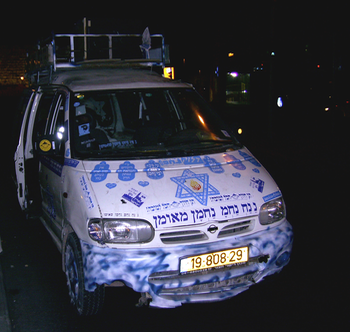Automobile manufacturers are in the news lately. Tesla had a huge fail during the marketing “reveal” of their new Cybertruck, when a steel ball thrown at the window smashed through the supposedly unbreakable armored glass. Dozens of companies are working on self-driving cars, including Amazon, Bosch, Apple, and Samsung, along with many traditional auto manufacturers. And the movie Ford V Ferrari starring Matt Damon and Christian Bale highlights the true story of Henry Ford II and Lee Iaococca as they attempted to create a racing car that could defeat the dominant Ferrari at the 1966 24 Hours of Le Mans race in France. Meanwhile, an Israeli startup named REE has brought their own ingenuity to auto design. What is the unique feature of the automobile they are developing?

Breslau Car-1 by zeevveez is licensed under CC BY 2.0.
A. Addressing the very high rate of injuries and deaths from auto accidents in Israel, REE has developed a car that will not crash into other vehicles, road signs, trees, or pedestrians. The car utilizes the Iron Dome technology developed by the Israeli defense industry. Sensors mounted on the front of the car detect potential obstacles ahead and immediately launch intercept rockets to eliminate the potential collision risk. The car’s production is on hold, however, as the courts attempt to resolve a lawsuit filed by the Israeli Safe Streets Association, a pedestrian-safety organization which objects to missiles being launched at jaywalkers.
B. Utilizing technology developed by Israel’s energy industries, REE has created a car which is completely powered by solar panels on its roof. The difficult part of the project was not the collection of solar energy (though the solar panels eliminate the ability to have a sunroof or moonroof on the car), but rather the storage of the energy for use at night or during periods of limited sunshine. Israeli engineers at the Technion Institute were able to develop storage batteries that are a built-in component of the car’s chassis and doors.
C. REE engineers designed the car based on the hoverboards which have become ubiquitous in Israel and elsewhere. The car does not have a front engine and steering mechanism, but rather functions with all of the major components (motor, brakes, drivetrain, steering, etc) built into the wheels, which are topped by a flat skateboard chassis.
D. Utilizing one of Israel’s most abundant resources, REE has developed a car engine that runs on salt water. The high electrical conductivity of salt water makes it a product that is very conducive to energy-producing reactions, and the only emission is clean water. The car is also lightweight, as all of the engine components are made of aluminum, to avoid the possibility of rust formation from the salt water.
E. Engineers at REE have designed an “Orthodox friendly” minivan, which they are calling the ChassidiVan. The 6-person vehicle is built with an expandable accordion design, allowing the car to be lengthened as the size of the family grows, ultimately accommodating up to 12 passengers. The car is programmed to automatically stop driving 20 minutes before sundown on Friday nights and holidays, and won't start up again until Shabbat or the holiday ends. The Diaspora model is specifically designed for export sales, as it is programmed to shut down for two days on the major holidays. The ChassidiVan also comes with a raised roof over the driver’s seat, based on the cupola top of the Israeli Merkava tank, to accommodate the tall shtreimel hat worn by religious drivers. Plus, the vehicle features 8 milchig and 8 fleishig cupholders.







